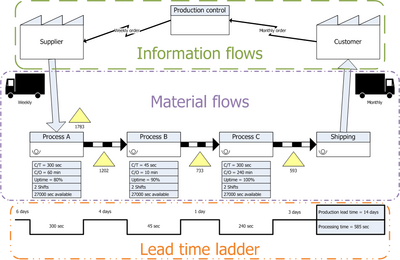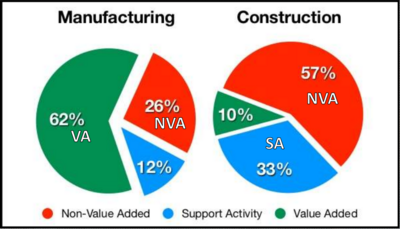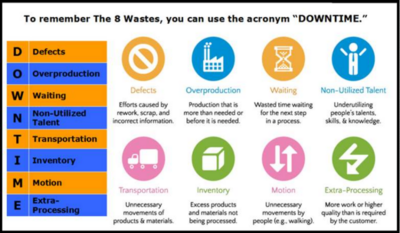Value stream mapping in construction management
(→Case study - Brazilian building company - Masonry stage) |
(→Case study - Brazilian building company - Masonry stage) |
||
| Line 105: | Line 105: | ||
=== Case study - Brazilian building company - Masonry stage === | === Case study - Brazilian building company - Masonry stage === | ||
| − | http://iglc.net/Papers/Details/356 | + | <ref name="brazilian">Fernanda Pasqualini & Paulo Antônio Zawislak, (2005) http://iglc.net/Papers/Details/356 (20-06-2017)</ref> |
In this sense, more than simply to | In this sense, more than simply to | ||
Revision as of 10:20, 20 June 2017
In this article, the introduction and implementation of VSM to the construction industry will be discussed. Initially a generic formulation of VSM is presented, follow by the introduction of VSM in the construction industry. The application of VSM in the construction industry will then shortly be discussed, based on case studies. Lastly the limitations associated with the use of VSM in the construction industry will be presented.
Contents |
The Big Idea
VSM generic formulation

Value stream mapping (VSM) originated in the manufacturing industry. It was developed by Toyota Motors Corporation, being a part of their Lean management tools. The Lean management philosophy is to identify and eliminate every activity in the design, production and supply chain management related processes that does not create value for a costumers point of view[2]. Generally it is characterized as a process-improving management philosophy, that seeks to minimize the waste without decreasing the productivity.
Let's first define what a "Value stream" is. The formal definition is as follows: "All the steps both value added and non-value added, required to take a product or service from row material to the waiting arms of the customer".
Value stream mapping (VSM) is used to both analyse and design the flow of material and information, that is required to bring a product or service to the end customer. It is a visual tool that provides a holistic view of the overall process, and thus a platform for strategically improvement and adding value to the costumers[3]. It has also been used to initiate a systemic implementation of the Lean production tools. The goal is to design an “ideal state”, also known as the “future state” by analyzing the “current state”. The current state presents how the process is at the time of making the VSM. This is very important due to the dynamic nature of VSM. An enormous amount of waste or in Japanese (Muda) is often present within the a work flow system. This waste is identified by reflecting the current state. The future state represents the state where the all the identified waste has been eliminated.
The general mapping of a current state is presented in Figure 1, showing the three key points:
- Information flow
- Material flow
- Lead time ladder
The overall lead time of the product or service is an important part of a VSM. Usually significant amount of non-value added activity or waste is found, and takes an enormous amount of time. Having identified the wastes, a future state can be designed where the wastes are eliminated, often applying additional Lean tools to achieve it. Standardized symbols are used when mapping a process state, to obtain a common language for communicating through the VSM[4].
VSM in the construction industry

The construction industry in terms of productivity, quality and efficiency, is often characterized as a backward industry, that fails to innovate compared to other industries. The Lean Thinking philosophy way introduced to the construction industry in 1993, and some successful implementations has been achieved. The major difference between the manufacturing- and construction industry is uniqueness related to a building project. Unlike, for instance in the car industry, the assembly line has been used since it's first implementation in the early 20th century. This automation of a standardized product cannot directly be implemented in the building industry due to the unique nature of building projects. However increasing automation is seen in constituent parts of construction project, as in pre-fabrication of concrete elements. This has furthermore been shown reduce both energy consumption and cost. The Construction Industry Institute states that only 10% are value added inputs and striking 57% are waste. This is compared to the manufacturing industry where 62% is value added and 26% is waste[2]. The lack of performance in the construction industry compared to other industries, has been directly related to the low rate of innovation. Another issue is the competition for building project, mainly in the public projects, which is cost centered. The cheapest bid wins the project, and under these circumstances bidders invest very little amount of time, money and vitality in advance[3]. These statistics are a major motivation, for studying and identifying the wastage, which is frequently present in the industry. Consequently how to apply Lean tools and techniques to reduce the wastage. Examples of value adding activities are pouring concrete, erecting steel or installing the roof. Examples of waste are excessive material handling, design errors, conflict between contractors, ineffective supply chain and rework.
8 types of waste in the construction industry

The following table list the 8 types of waste, typically found within the construction industry[5].
| Waste type | Definition/cause | Example |
|---|---|---|
| Inventory | Excess products and material not being processed. | Steel door frames delivered in bundles during steel erection. (Early delivering - just to be safe) |
| Motion | Unnecessary movements by people (e.g. walking). | Early delivery of the steel door frames got in the way of production operation and had to be moved. |
| Defects | Efforts caused by rework, scrap, and incorrect information. | In the process of moving the early delivered steel frame doors, some were damaged. |
| Extra-Processing | More work or higher quality than is required by the costumer. | Some of the damaged doors were repaired, and spending time ordering new doors. |
| Non-Utilized Talent | Under-utilizing peoples talents, skills and knowledge. | Carpenters moved the steel frames to the construction install area. |
| Transportation | Unnecessary movements of products and materials. | New doors has to be delivered on site. |
| Waiting | Wasted time waiting for the next step in a process. | Waiting for the new doors to be delivered. |
| Overproduction | Production that is more than needed or before it is needed. | Due to lack of doors to install, the carpenter began on other tasks too early. |
These 8 types of wastage can be recognized as "DOWNTIME", see Figure 3.
Application
Regarding the application of VSM in the construction industry, no unique guidelines has yet been made on how to implement it[3]. Unlike the manufacturing industry, all construction projects has unique design specifications, and there is very little repetition involved and too much variability. Due to the lack of generic guidelines, some case studies will be examined instead.
Case study - Precast concrete yard
A paper by (Nimesha Vilasini & J. R. Gamage, 2010)[2], presents a case study of the application of VSM at a precast concrete yard. The aim was to resolve quality issues and reduce the cycle time. Initially process information were gathered, and reflecting the current operation status, a current value stream map were created. The waste generating activities were identified, and by use of different analysis tools (Five whys and Cause and effect diagram), the root to the issues were found, and solved by a Kaizen approach. Subsequently a future state map was created to provide guidelines for future lean activities, and to monitor each Kaizen process.
The major steps involved in the mapping is summarized in following table:
| Steps | Description |
|---|---|
| Preparation stage | What product or project to study, and how it should be mapped. Additionally find a mapping team. |
| Current state map | Collection of data from each individual process, and connecting all the states of production to establish the flow information and material resources. |
| Future state map | Analyzing the current state map, and searching for areas where improvements could be performed, and possible solutions to there were discussed. |
| Planning and implementation | The future state map were completed for each identified issue, and an action plan were developed to visualize and share information about Kaizen projects. |
Case study - Brazilian building company - Masonry stage
In this sense, more than simply to identify wastes, the systemic visualization shows the reasons wastes exist, or its origin. Thus, the improvements proposed aim to solve the problem at its source and not only “to cover it up”.
Aiming to introduce the ideas of Lean Production in construction in a more systematic way, identifying its main problems and proposing actions for improvement throughout the value flow, this article describes the modifications and application of the VSM in a Brazilian construction company. Modifications of VSM were necessary due to the difference between manufacture and construction. Through its application it was possible to identify problems and to consider some actions for improvement, turning it into a more fluid production, with fewer stops and increasing the planned flow versus the accomplished one.
With the objective of viewing the productive pro- cess in construction in a systemic way, in order to start a systemic implementation of Lean Construction, VSM was used in this study.
In spite of VSM having been used with success by different industrial sectors, its application in the productive activities of construction still hasn’t been disseminated
this one has been developed in a manufacturing environment, and considers the characteristics and necessities of this environment, which differ from those of the productive environment in construction. Because of that, some adaptations were necessary, in each stage, for its application in construction.
1 Selection of a construction stage
Considering that VSM should be started inside an industrial plant, in the manufacturing process, and that in construction the manufacturing process occurs on the building site, a construction was selected from a Brazilian building company (contractor) for VSM application. Moreover, mapping should not be initiated in all products manufactured by the company, but a family of products should be selected.In the case of construction, however, because each large stage occurs progressively during a long period of time and has different processes producing different products (which, in the end, result in the product “building”), each one could be considered a kind of “sub-fabric” (or “sub-construction”) inside the industrial plant (or construction site). Thus, instead of selecting a family of products to initiate VSM in construction, one should select a stage of the productive process of construction, which in this case was the masonry stage.
Subtitle
A thesis by YAXU LI[3], states that based on literature search, the application of VSM in the construction industry can be divided into three themes: construction process, macro-process, and construction support processes.
Limitations
Value stream mapping as a generic Lean tool, cannot be directly applied in the construction industry. It has a huge potential, but modifications and redesign are required for the tool to be generic applicable in the industry. Relevant customization to the tool must be carried out to shown a significant effect. The limitations are centered around the fact that it was originally adopted in a manufacturing environment. [2][3] .
Annotated Bibliography
- ↑ Value stream mapping https://en.wikipedia.org/wiki/Value_stream_mapping (19-06-2017)
- ↑ 2.0 2.1 2.2 2.3 Nimesha Vilasini & J. R. Gamage (2010) https://www.researchgate.net/publication/282156168_Implementing_Value_Stream_Mapping_Tool_in_the_Construction_Industry (19-06-2017)
- ↑ 3.0 3.1 3.2 3.3 3.4 YAXU LI, Master thesis (2015) http://oaktrust.library.tamu.edu/bitstream/handle/1969.1/156276/LI-THESIS-2015.pdf?sequence=1&isAllowed=y (19-06-2017)
- ↑ Strategosinc - symbols (rev. 2017) http://www.strategosinc.com/vsm_symbols.htm (19-06-2017)
- ↑ 5.0 5.1 5.2 Robert Warcup, PhD (2016) http://c.ymcdn.com/sites/www.nasfa.net/resource/resmgr/Learning_Series/Intro_to_Lean_Construction_&.pdf (19-06-2017)
- ↑ Fernanda Pasqualini & Paulo Antônio Zawislak, (2005) http://iglc.net/Papers/Details/356 (20-06-2017)